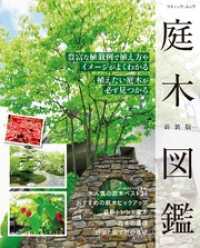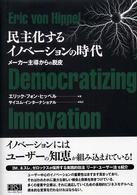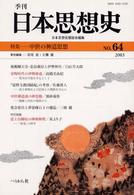- ホーム
- > 洋書
- > 英文書
- > History / World
Full Description
Excavation at Hereford Cathedral took place in 1993, prior to the construction of the Mappa Mundi Museum and new archive library. This revealed extensive remains, some potentially dating back to the 7th/8th century, including timber-built buildings and a late Saxon cemetery. Around the year 1000, major change saw a roadway installed and a new, very substantial building erected, the latter possibly the bishop's residence at the time. Its occupation ceased in the mid-11th century, the cellar being converted into a cesspit, where a late Saxon sword was discovered. The Welsh ransacking of Hereford in 1055 probably accounts for this drastic decline.
Subsequently a large gravel/sand quarry was excavated, thought to signify the construction of the Norman cathedral. Backfill to the quarry included a very large quantity of charnel (up to 5000 people), some dating to the later 8th/9th century. Strangely, towards the end of the charnel deposition, a few contemporary burials were also incorporated, some being irregular in their layout and so possibly signifying a major cataclysm, such as famine.
Thereafter, the site was given over to a cemetery from c. 1140 onwards, and excavation of over 1000 burials has provided a full cross-section of the medieval population. Almost 200 individuals were associated with three pits. These are considered to date from the first outbreak of plague in Hereford in 1349, notoriously the 'Black Death', and such mass graves would echo similar responses elsewhere, both in the UK and Europe-wide. The site has contributed to an international study, using aDNA analysis, to successfully identify the presence of Yersinia pestis, and so demonstrate its agency in this catastrophe.
In addition to detailed reporting on some notable individual artefacts, there is a thorough study of the human remains, while the interpretation of the entire stratigraphic sequence is underpinned by extensive radiocarbon dating and chronological modelling.
Contents
List of figures
Acknowledgements
Contributors
Summary
1 Introduction, by Derek Hurst (with contributions by Pat Hughes and Ron Shoesmith)
2 Structural evidence, by Derek Hurst
3 Radiocarbon dating and chronological modelling, by Peter Marshall, Derek Hurst, Christopher Bronk Ramsey, Elaine Dunbar, Sanne Palstra, Paula Reimer and Marie C Weale
4 Ceramics, by Derek Hurst and Alan Vince†
5 Metalwork, by Derek Hurst (with a note on a harness fitting by Aisling Nash)
6 The Hereford sword: technological investigation and appraisal, by Brian Gilmour
7 Coins and other possible numismatic finds, by David Symons
8 Worked flint, by Rob Hedge
9 Other artefacts, by Derek Hurst (with a note on the salmon bead by Sheila Hamilton-Dyer)
10.1 Human skeletal remains, by Darlene Weston, Alan Ogden and Anthea Boylston
Appendix 1: Demography, by Darlene Weston
Appendix 2: Stature and metrics, by Anthea Boylston
Appendix 3: Non-adult growth, by Darlene Weston
Appendix 4: Enthesopathy, by Anthea Boylston
10.2 Life and death at Hereford Cathedral, by Sarah Stark
11 Disarticulated human remains from the charnel pit, by Hannah Haydock, Gemma Burton and Jo Buckberry
12 DNA analysis of the plague in Hereford, by Stephanie Hänsch, Darlene Weston and Barbara Bramanti
13 Multi-isotopic analysis, by Peter Marshall, Gundula Müldner and Jane A Evans
14 Faunal remains, by Ian L Baxter (with contributions by Karis Baker and Sheila Hamilton-Dyer)
15 Environmental remains, by Elizabeth Pearson
16 Death, funerals and burials in late medieval Hereford: the documentary evidence, by Ian Forrest
17 Overall discussion and conclusions, by Derek Hurst
Bibliography
-

- 電子書籍
- 庭木図鑑 新装版
-

- 電子書籍
- 契約秘書~強引社長の命令で婚約者になり…






